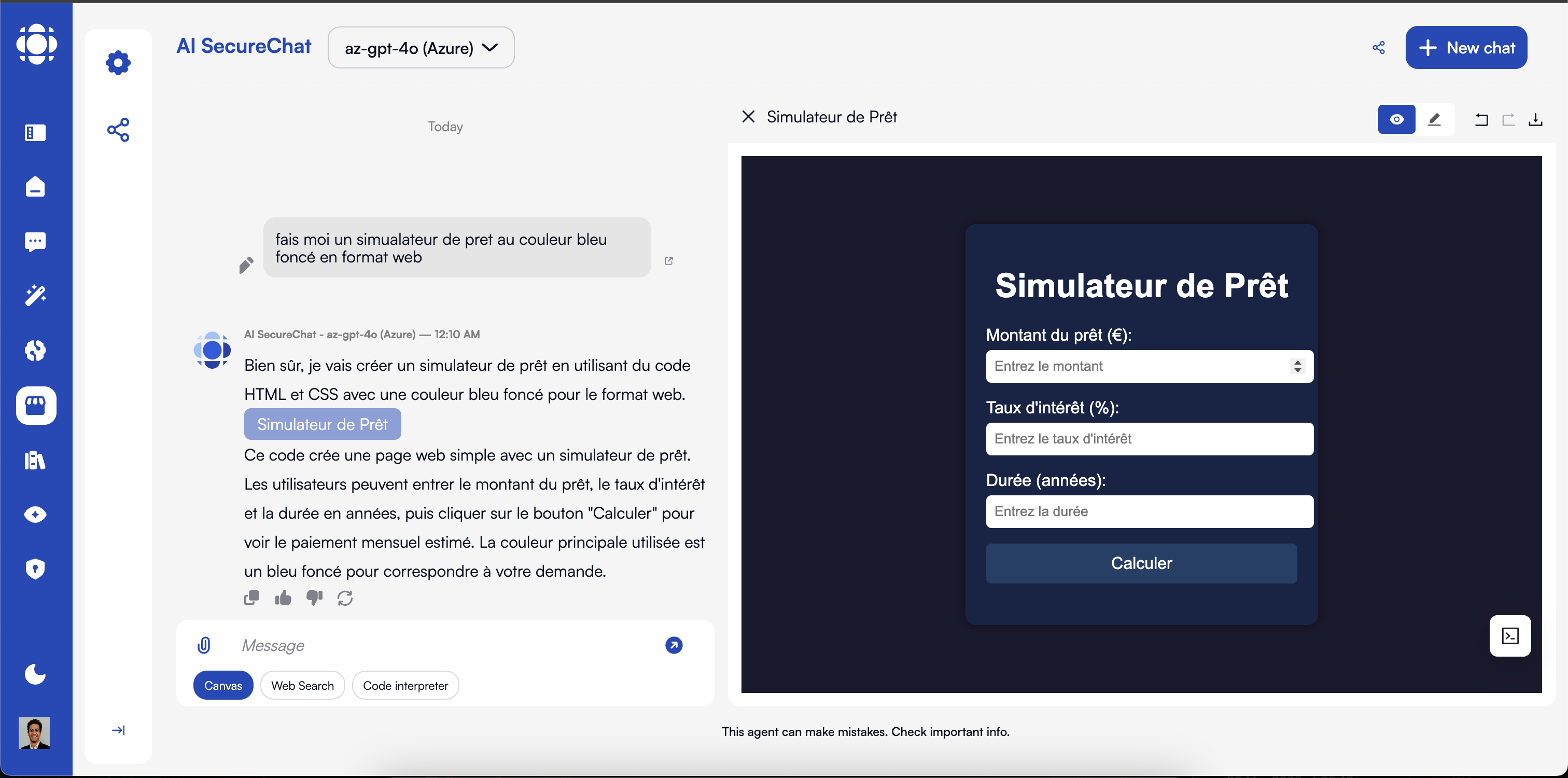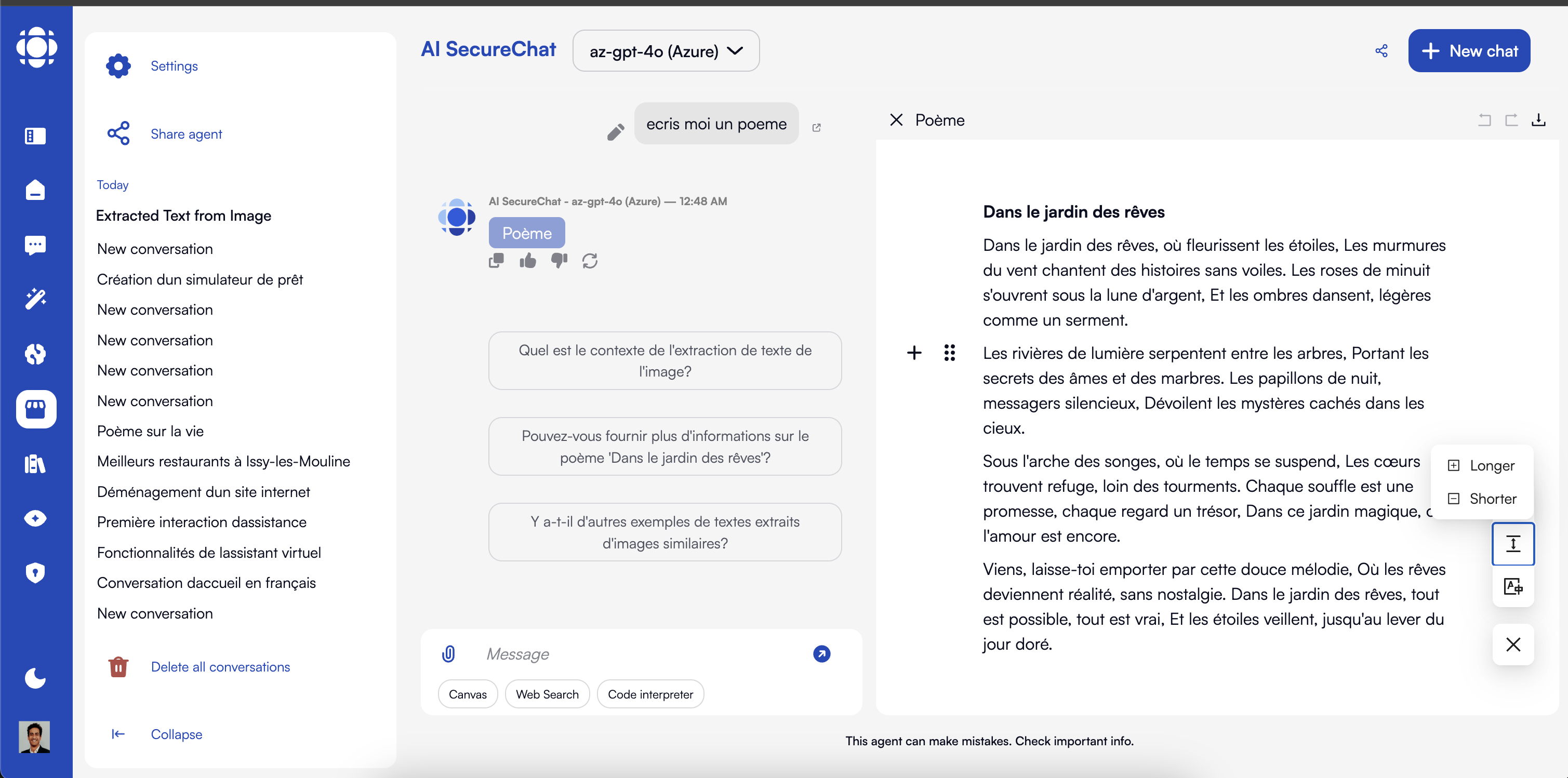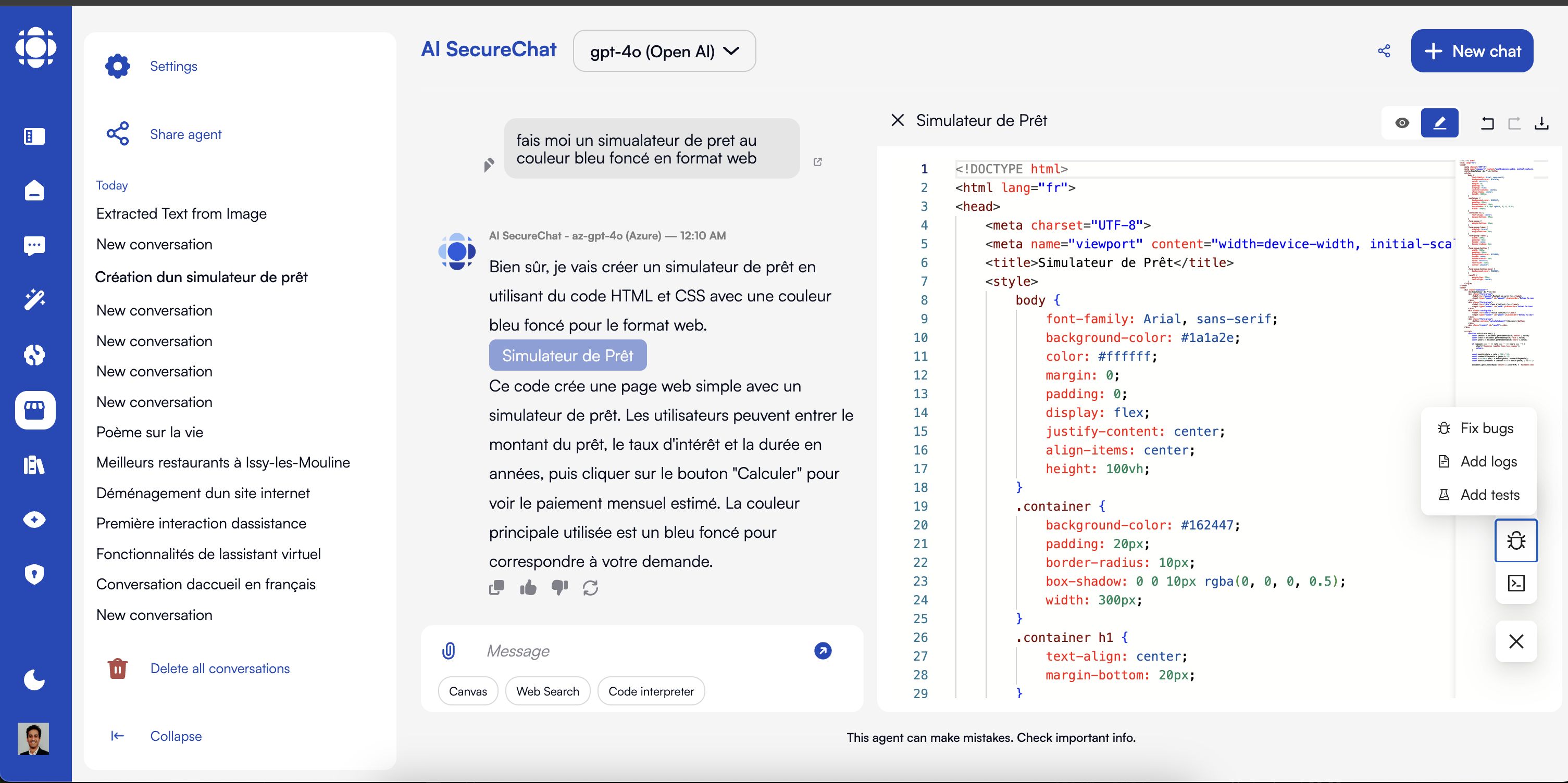
Overview
Canvas transforms AI Agents from a conversational interface into a full-featured workspace where you can:- Create polished documents and content
- Develop and test code
- Collaborate with colleagues
- Get AI assistance throughout the creative process
Key Features
Rich Content Editor
Create formatted text with advanced styling options
AI-Assisted Editing
Get contextual suggestions and assistance as you work
Code Workspace
Develop, test, and visualize code with syntax highlighting
Collaborative Editing
Work together with colleagues in real-time
Multiple Export Options
Save your work in various formats
Version History
Track changes and revert when needed
Content Templates
Start from pre-designed formats for common content types
Seamless Chat Integration
Switch between conversation and Canvas modes
Accessing Canvas
1
Open Canvas from conversation
Click the Canvas button in the message input area of any AI agent conversation.
2
Select workspace type
AI detects the type of Canvas workspace you want to open depending on your request.Options include:
- Document - For text-focused content
- Code - For programming and development
- Visual - For design-oriented content (where available)
Canvas for Non-Technical Users
Canvas provides a rich environment for creating and editing text documents:
Document Creation Features
- Text Formatting
- Layout Options
- Content Elements
- Document Structure
Canvas offers comprehensive text formatting options:
- Headings and subheadings
- Bold, italic, underline, strikethrough
- Bullet and numbered lists
- Block quotes and code blocks
- Tables and dividers
- Text alignment and indentation
- Font selection and sizing
- Text and background colors
AI Assistance for Content Creation
Access AI capabilities through the context menu (right-click or use the ⋮ button):Generate Content
Generate Content
Ask the AI to create new content based on your instructions:Example prompts:The AI will generate content directly in your document where you can further edit and refine it.
Edit & Improve
Edit & Improve
Get AI help to enhance your existing content:Editing options include:
- Rewrite - Completely rework the selected text
- Improve - Enhance clarity and quality while preserving meaning
- Summarize - Create a shorter version of the selected content
- Expand - Add more detail and depth to brief content
- Fix grammar & spelling - Correct errors while preserving style
Change Style & Tone
Change Style & Tone
Adjust the voice and style of your content:You can modify content to be:
- More formal or casual
- Technical or simplified
- Persuasive or informative
- Concise or detailed
- Enthusiastic or reserved
Translate
Translate
Convert your content to different languages:Features include:
- Translation to major world languages
- Preservation of formatting during translation
- Ability to specify formality level
- Culturally appropriate adaptations (optional)
Intelligent Context Menu
The context menu provides intelligent suggestions based on your selected canvas: For example:- When selecting a canvas, you might see options for rewriting or improving
- When selecting a canvas, you might see options for generating content beneath it
- When selecting an canvas, you might see options for completing it
- When selecting a canvas, you might see options for polish it for a final version
Canvas for Technical Users
The Code workspace in Canvas is optimized for software development and technical content:
Code Development Features
- Editor Capabilities
- Execution Environment
- Live Preview
- Visual Tools
The code editor includes:
- Syntax highlighting for multiple languages
- Line numbering and code folding
- Automatic indentation
- Bracket matching
- Error and warning indicators
- Code completion suggestions
- Multi-cursor editing
- Find and replace functionality
AI Assistance for Code Development
The specialized context menu for code offers:Generate Code
Generate Code
Create new code based on your specifications:Example prompts:The AI will generate functional code that you can directly test in the execution environment.
Improve Code
Improve Code
Enhance existing code quality and functionality:Improvement options include:
- Optimize - Make code more efficient
- Refactor - Restructure for better readability and maintainability
- Debug - Find and fix errors
- Complete - Finish partial implementations
- Add Error Handling - Implement robust error checking
Documentation
Documentation
Generate documentation for your code:Documentation features:
- Generate comments for functions and classes
- Create JSDoc/Docstring style documentation
- Write README files
- Explain complex algorithms
- Generate usage examples
Testing
Testing
Create tests for your code:Testing capabilities:
- Generate unit tests
- Create test cases for edge conditions
- Build integration tests
- Implement mocks and fixtures
- Write test documentation
Convert & Adapt
Convert & Adapt
Transform code between languages and frameworks:Conversion options:
- Port code to different programming languages
- Convert between frameworks (e.g., React to Vue)
- Update code to newer language versions
- Transform between paradigms (e.g., imperative to functional)
Specialized Code Tools
- Version Comparison
- Dependency Management
- Debugging Assistance
Compare different versions of your code:
- Side-by-side diff view
- Highlighted changes
- Change history tracking
- Conflict resolution assistance
Multimodal Capabilities in Canvas
When using Canvas with compatible LLM models, you can work with images and visual content:Working with Images
1
Import images
Add images to your Canvas workspace using the import button or by pasting directly.Supported image formats include PNG, JPG, JPEG, GIF, and SVG.
2
Analyze visual content
Get AI assistance understanding and working with images:Image analysis capabilities:
- Detailed descriptions of image content
- Text extraction from images (OCR)
- Chart and graph data extraction
- Object and entity recognition
- Visual concept explanation
3
Edit and transform
Modify images or generate new visual content:Basic image operations supported:
- Cropping and resizing
- Simple adjustments (brightness, contrast)
- Text addition to images
- Image generation from textual descriptions (with compatible models)
- Basic diagram creation
Collaboration Features
Work together with colleagues in the Canvas workspace:Real-Time Collaboration (available soon)
1
Share your Canvas
Invite others to collaborate on your Canvas workspace:Sharing options:
- View-only access
- Comment access
- Edit access
- Time-limited collaboration
2
Collaborate in real-time
Work simultaneously with colleagues:Collaboration features:
- See others’ cursors and selections
- View changes as they happen
- User presence indicators
- Collision prevention
3
Comment and discuss
Add comments and feedback directly in the document:Comment capabilities:
- Add comments to any part of the content
- Tag specific collaborators
- Reply to existing comments
- Resolve comment threads
- Comment notifications
Version Control
Track changes
Track changes
Keep a history of all modifications to your Canvas content:Version history features:
- Automatic saving at regular intervals
- Named versions for significant milestones
- Complete change history
- Author tracking for each change
- Timestamp information
Restore previous work
Restore previous work
Revert to earlier versions when needed:Restoration options:
- Restore the entire document to a previous state
- Selectively restore specific sections or elements
- Create a new branch from an older version
- Merge changes from different versions
Exporting Canvas Content
Save your work in various formats for use outside of AI SecureChat:Document Export Formats
Word (.docx)
Editable Microsoft Word document
Markdown
Text-based markup for maximum compatibility
HTML
Web page format for online sharing
Plain Text
Simple text format without formatting
Code Export Formats
Source Files
Raw source code files (.js, .py, etc.)
GitHub Gist
Share code snippets via GitHub
CodePen/JSFiddle
Interactive web code environments
Markdown
Code with documentation in markdown format
Executable Script
Runnable scripts with appropriate shebangs
Best Practices for Canvas
Start with a Clear Structure
Begin with an outline or template to organize your content effectively.
Use AI Throughout the Process
Leverage AI assistance at different stages, not just for initial generation.
Iterate and Refine
Use multiple rounds of feedback and improvement rather than expecting perfection immediately.
Combine Human and AI Strengths
Provide creative direction and critical thinking while letting AI handle repetitive tasks.
Save Versions at Milestones
Create named versions at significant points to track progress and enable rollback if needed.
Test Code Thoroughly
Use the execution environment to verify that generated code works as expected.
Customize Output for Your Brand
Adapt AI-generated content to match your organization’s voice and style.
Export in Multiple Formats
Save your work in different formats for various use cases and platforms.
Canvas vs. Chat Mode: When to Use Each
- Use Canvas When...
- Use Chat Mode When...
Troubleshooting Common Canvas Issues
Performance slowdowns
Performance slowdowns
If Canvas becomes slow or unresponsive:
- Reduce the amount of content in a single Canvas (break into smaller documents)
- Close other browser tabs and applications
- Disable real-time preview for large code projects
- Limit the number of embedded images and complex elements
- Consider saving your work and starting a fresh Canvas
Formatting problems
Formatting problems
If you experience issues with formatting:
- Try selecting the problematic content and applying formatting again
- Use the “Clear formatting” option and reapply styles
- Check for conflicting style settings
- For persistent issues, copy the content to a new Canvas
- Use simpler formatting for better compatibility
Code execution errors
Code execution errors
When code fails to execute properly:
- Check the console for specific error messages
- Verify syntax for the specific language you’re using
- Ensure all dependencies are properly imported
- Try running smaller code segments to isolate the issue
- Use the AI to help debug by selecting the error and asking for assistance
Collaboration conflicts
Collaboration conflicts
If multiple users experience editing conflicts:
- Establish clear sections for different collaborators
- Use the comments feature instead of simultaneous editing in the same area
- Take turns editing sensitive parts of the document
- Save versions frequently during collaborative sessions
- Consider using Canvas sharing with view/comment permissions for larger groups